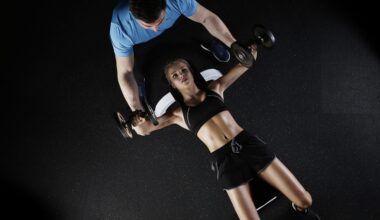Increasing Flexibility with Pilates: Tips for Women
Flexibility is an essential component of health, especially for women who engage in fitness routines. Incorporating Pilates into your weekly exercise can significantly enhance your flexibility. Pilates focuses on controlled movements, promoting muscle elongation and flexibility. To start, it’s important to wear comfortable attire that allows for freedom of movement. Choosing the right mat helps reduce strain during exercises. Consult a professional instructor for personalized guidance, ensuring that your technique aligns with your body’s needs. Start with beginner classes to understand the foundational principles and progress gradually. Pay attention to your breathing, as it coordinates movement and enhances relaxation. Regular practice not only increases flexibility but also builds strength and stability. It’s vital to commit to consistency; aim for at least three sessions weekly to see substantial improvements. Combining Pilates with other stretching routines also proves beneficial. Stay hydrated, as proper fluid intake supports muscle elasticity. Set realistic flexibility goals to remain motivated. Keeping a journal of your progress can boost your dedication. With duration and consistent effort, enhanced flexibility through Pilates is within reach for every woman.
To fully realize the benefits of Pilates for flexibility, consider integrating various techniques. Focus on exercises targeting different muscle groups, ensuring a balanced routine. Key movements such as the Saw, Roll-up, and Spine Stretch can significantly improve spinal and hamstring flexibility. Additionally, performing dynamic stretches before each session prepares your muscles effectively. Be mindful of the alignment of your body throughout each exercise; proper posture not only maximizes results but also minimizes risk of injury. It helps to visualize each stretch as you do them; this mental imagery reinforces the connection between your body and mind, further enhancing flexibility. Moreover, Pilates emphasizes a mind-body connection, which can help in understanding how your body moves. Incorporate a variety of props, such as resistance bands and blocks, to deepen your stretches and explore new ranges of motion. Following instructors via online video classes also allows you to practice in the comfort of your home. Consider joining a supportive community, either online or in-person, to share experiences and stay accountable. Enhancing your flexibility through Pilates opens the door to greater enjoyment in all physical activities.
Common Misconceptions about Pilates
Many assume that Pilates is solely for elite athletes or advanced practitioners; this misconception can deter beginners from exploring its benefits. On the contrary, Pilates welcomes participants of all fitness levels. The focus on individual progression, rather than competition, makes Pilates an inclusive practice. Beginners can modify exercises to suit their abilities and gradually build strength and flexibility. Additionally, Pilates is not just about flexibility; it strengthens the core, enhances posture, and promotes overall wellness. It emphasizes controlled movements, which teach practitioners how to move more efficiently in daily activities. Another misconception is that Pilates is easy and lacks intensity. However, it can be surprisingly challenging, as exercises require concentration and proper execution. Many people experience sore muscles after a Pilates session, highlighting its effectiveness. It’s essential to approach Pilates with an open mind and view it as a journey. Over time, participants can notice significant improvements in flexibility and overall body control. Seeking guidance from certified instructors ensures effective results, making it ideal for women aiming to increase their flexibility safely.
Nutrition plays a crucial role alongside Pilates in achieving flexibility goals. Consuming a balanced diet rich in vitamins and minerals supports muscle recovery and growth. Incorporate plenty of fruits and vegetables, which provide essential antioxidants to combat muscle inflammation. Foods containing Omega-3 fatty acids, like salmon and walnuts, can also enhance joint health. Staying hydrated is vital, as dehydration can lead to muscle stiffness. Aim for at least eight glasses of water daily, adjusting according to your activity level. Additionally, consider small, nutritious snacks before Pilates sessions to fuel your body. Whole grains and protein-rich foods are excellent choices. Post-workout nutrition is equally important for muscle repair. Choose a combination of proteins and carbohydrates to replenish energy stores. Greek yogurt with berries or a smoothie can be ideal recovery options. Women should listen to their bodies, adjusting food intake based on how they feel during their sessions. Remember, a holistic approach to health will maximize the benefits of Pilates in improving flexibility. Over time, you’ll observe not only increased flexibility in movements but also greater overall wellness, contributing to your fitness journey.
Mindfulness in Pilates Practice
Practicing mindfulness during Pilates enhances both flexibility and mental clarity. Focusing on the motions helps gain awareness of body alignment, making each movement purposeful. When paying close attention to how each muscle engages, you can better understand your body’s needs. This mindful approach also contributes to reducing stress and anxiety levels, creating a healthier mindset around flexibility and fitness. Implement breathing techniques throughout your sessions; inhaling and exhaling deeply maintains a rhythm and fosters relaxation. Integrate meditation into your routine as well; taking a few moments each day to sit quietly can improve focus. As you flow through Pilates exercises, mentally acknowledge how your body feels during each stretch, celebrating small progressions. Developing a positive mindset around flexibility transforms your relationship with fitness. Acknowledge that improvement takes time and patience, steering clear of negative comparisons with others. Recording achievements strengthens this mindset; keeping track of progress creates motivation and reinforces your journey. Pilates promotes a harmonious connection between body and mind; engaging deeply in your practice amplifies the benefits. Cultivating mindfulness ultimately leads to a more enjoyable and fulfilling experience with Pilates, enhancing flexibility over time.
Remaining adaptable within your flexibility journey can accelerate results. If you introduce Pilates and don’t notice immediate improvements, adjust your regimen accordingly. It may involve varying intensities of workouts, scheduling additional sessions, or exploring complementary forms of exercise. Activities such as yoga or dancing can provide alternative routes to improving flexibility. Being flexible about expectations is crucial; not all bodies achieve results at the same pace. Adaptability in your routine allows for exploring different Pilates styles, such as mat versus reformer Pilates. Regularly updating your goals can also create motivation, maintaining engagement during your practice. Remember that every session adds up over time, and patience truly pays off. Utilize online platforms to diversify your practice and learn from various instructors. Attending workshops or special classes can infuse new inspiration into your routine. Reaching out to fellow practitioners helps in sharing tips and experiences. Create a supportive network by connecting with others on similar journeys, encouraging each other through challenges. Embracing adaptability while practicing Pilates ultimately enhances flexibility and fulfills personal fitness aspirations, paving the way for continued growth and progress.
Conclusion and Commitment
In conclusion, committing to Pilates can lead to substantial improvements in women’s flexibility. A consistent practice can enhance not only flexibility but also overall fitness and well-being. Adopting a holistic approach, incorporating nutrition and mindfulness, completes the journey toward improved flexibility. Celebrate every step along the way; small achievements accumulate to create lasting impacts. Set aside specific times for Pilates in your weekly schedule to ensure prioritization. Choose a variety of routines to keep your body challenged and engaged. Explore resources and connect with communities that offer support and encouragement. Pilates is not merely a workout but a way to learn about your body’s capabilities, ultimately enhancing flexibility. Recognize your body’s limits and progress at your own pace, integrating rest days for recovery. Appreciate the path to flexibility, knowing results come at different speeds. With commitment, you will notice positive transformations not solely in flexibility, but in your overall perception of health. Continue to explore, practice, and commit, letting Pilates guide you toward a healthier, more flexible lifestyle. Your journey begins today, and flexibility is within reach.
Ultimately, remember that the journey to increased flexibility with Pilates is a testament to your dedication. The blend of exercise, nutrition, and mindfulness enhances your experience and cultivates both physical and mental strength. With patience and consistency, you will celebrate improved flexibility while enjoying the benefits of Pilates. Stay inspired throughout your fitness journey, and embrace the transformative power that Pilates holds. The practice is adaptable and personal, allowing each woman to find her unique path to flexibility.


